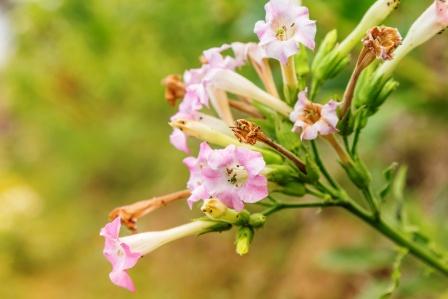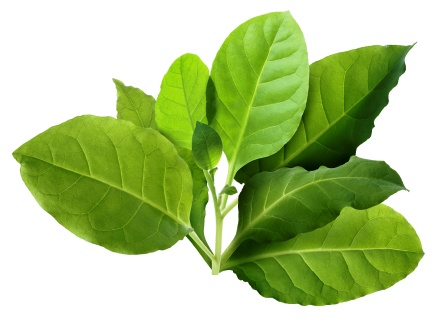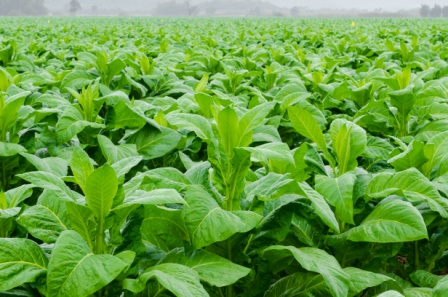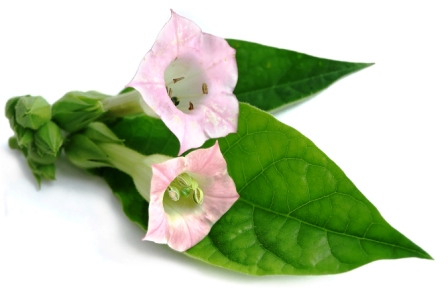Nicotiana tabacum – Tobacco Medicinal Uses, Research
Tamraparna- Nicotiana tabacum is a plant which is not mentioned in the classical texts of Ayurveda but mentioned in the later texts. It is used for the treatment of joint pain, dental caries, gingivitis, strychnos poisoning and is also used as a nerve stimulant.
Latin name- Nicotiana tabacum Linn.
Family- Solanaceae (Kantakari kula)

Table of Contents
Vernacular names
Names in different languages:
Hindi name- Tambaku
English name- Tobacco
Bengali name- Tamaka
Gujarathi name- Tamaku
Kannada name- Hogesoppu
Marathi name- Tambaku
Malayalam name- Pokal
Tamil name- Poga elai
Telugu name- Pogaku
Sanskrit Synonym
Gucchaphala- The fruits are found in cluster
Kalanj, Tamala

Morphology and habitat
Tamraparni popularly known as Tobacco is a plant cultivated in the plains of India having less rainfall and temperate climate. It is a small annual plant with weak stems and large leaves. It turns to a golden brown color when dried and hence the name Tamraparna. The leaf is later dried and used as tobacco in many products. The flowers are found in clusters. The plant is a native of America.
Properties, part used, dosage
Tobacco medicinal properties:
Rasa (Taste) – Katu (Pungent), Tikta (Bitter)
Guna (Qualities) – Laghu (Light for digestion), Teekshna (Strong), Vyavayi (Penetrating nature)
Veerya (Potency) – Ushna (Hot)
Vipaka – Katu (Undergoes Pungent taste after digestion)
Karma (Actions) – Kaphavata shamaka (reduces vitiated kapha and vata dosha), Pittavardhaka (Increases pitta dosha)
Prabhava (Special action) – Intoxicating

Part used- Dried leaf
Dosage- 1 to 2 g
Chemical constituents
Chemical constituents of Tambaku:
The leaf of the plant contains Nornicotine, Anatabine, anatalline, Solanofuran, Bombiprenone etc.
Sanskrit verse, Uses
तस्य पत्रं तु तीक्ष्णोष्णं कफवातहरं श्वासकासहं चैर्व कोष्टवातहरं तथा॥
वातानुलोमनकरं वस्तिशोधतमुत्तमम् ।
दन्तरुक् शमनं चैव क्रिमिकण्डूवादिनाशनम् ॥ ( यो.र)
Uses of Nicotiana tabacum:
- The dried leaf of tobacco is slightly heated, applied and tied over the joints affected with pain and swelling to reduce the complaints.
- The dried powder of the leaf is an antidote of Strychnous nuxvomica poisoning.
- The dried leaf of tobacco is burnt and the fume is inhaled in small quantities to control cough and snake bite poisoning by inducing vomiting.
- The powder of the dried leaf is kept in the teeth affected with dental caries to relievethe pain.
- The dried powder of the leaf is blown through the nose to treat cases of sinusitis and headache related to it.
- The dried leaf of tobacco is cardiac and nerve stimulant in doses of 1 to 2 g and hence used in cases of depression.

But people recognize tobacco for its adverse effect due to uncontrolled use. Regular and excess use of tobacco in smoking, chewing and other products lead to addiction and serious health hazards.
Adverse effects
Adverse effect of tobacco:
The regular and increased use of tobacco can lead to oral cancer, lung cancer. Apart from these, in acute cases headache, giddiness, respiratory distress can be seen.
Interaction with medicines, supplements
Can this be used while taking Homeopathic medicine?
Yes. This product does not react with homeopathic medicine.
Can this medicine be continued while taking supplements like multivitamin tablets, Omega 3 fatty acids etc?
Yes. Generally, this product goes well with most dietary supplements. However, if you are taking more than one product per day, please consult your doctor for an opinion.
With western
medicines
Seek your
doctor’s advice if you are taking this product along with other western
(allopathic / modern) medicines. Some Ayurvedic herbs can interact with modern
medicine.
If both Ayurvedic and allopathic medicines are advised together, then it is
best to take Allopathic medicine first, wait for 30 minutes and then take the
Ayurvedic medicine.
Research
Research articles related to Nicotiana tabacum:
Hypoglycemic effect: The aim of this study was to investigate the in vitro inhibition of α-amylase and α-glucosidase by extracts of N. tabacum leaf. The observed inhibitions of α-amylase and α-glucosidase suggest that the leaf extracts of N. tabacum may be useful in the management of Diabetes mellitus, which may be due to the presence of phytochemicals.
In- vitro anthelmintic effect: Researchers investigated the in vitro anthelmintic effect of aqueous and alcoholic extract of Tobacco (Nicotiana tabacum) against M. marshalli. The result showed that compared with Levamisole 50 mg/ml, dilution of 25 and 50 mg/ml of the aqueous extract had the same anthelminthic effects (P > 0.05), but 75 mg/ml dilution of the aqueous extract and dilution of 25, 50 and 75 mg/ml of alcoholic extract had more anthelmintic effect .
Author:
Dr.B.K.Prashanth M.D (Ayu), Ph.D
E mail: [email protected]
Sthanika karma (Systemic Acton)
External use
Analgesic, Anti inflammatory, AntiHelminthic in nature. Leaves are used to tie in scrotal inflammation, Joint pain etc. It can be used as tooth powder to prevent tooth decay. It can be used for Nasya in Kaphavata type of diseases.
Internally
Nervous system – First it stimulates the nervous system, further use can cause lassitude and tiredness.
Digestive system – In lower lose it stimulates the secretion of digestive enzymes. Increases intestinal motility, Facilitate proper movement of doshas. Can cause Nausea and vomiting sensation.
Circulatory System – At the beginning it slows down the circulatory system, but later increases the heart rate and hypertension.
Respiratory system – Slow down the respiratory rate in lower doses. In higher dose can cause respiratory distress
Excretory system – Increases the release of ADH Hormone, thus decreases urine production.
Reproductive system – Strong uterine stimulant, can cause abortion and preterm labor
Satmikarana -Over dose can cause Ojo kshaya and Dhatu kshaya (Tissue depletion) , Not good for eyes, diminishes eyesight. Indicated in Snake poisoning and in strychnine poisoning. Overdose can cause sluggishness, Insomnia, Cough, Body weakness, Anemia, Liver diseases, Loss of vision etc.











5 comments
Shenika Keis
Never thought tobacco plant will be this helpful. Thanks for the information and keep writing such intresting blogs.
Alex
Dear Vaidyaji,
If I make self-made cigarettes with pure (no additives) tobacco and add to this powders of Licorice, Tulsi, Pippali, Ginger and take a spoon of Licorice syrup after each cigarette, will it reduce adverse effect of tobacco on my respiratory system (if i smoke anyway)?
P.S. I do not like Nirdosh as a substitute.
Dr J V Hebbar MD(Ayu)Author
No. It will not be able to suppress the ill effects of Tobacco.
Aleksandrs
Dear doc,
One wisdom says: “The absence of reply is also reply…”.
So, thank you for “reply”! 😉
Ravi
In Ayurveda it is heating in nature by virtue of its virya and vipak. But in Unani it is considered extremely cooling and drying. I suspect the unani version to be true because all labourers chew this and work under harsh Sun all day long. Had it been heating ,they would have suffered a hell of a lot. Please clarify.